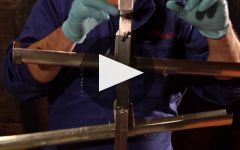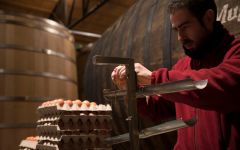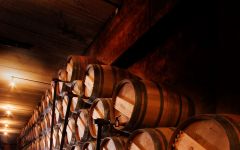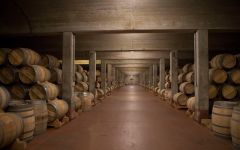Bodegas Muga Conde de Haro Cava Brut Reserva 2019
-
James
Suckling -
Wine
Enthusiast -
Robert
Parker -
Wine
Spectator



Product Details
Your Rating
Somm Note
Winemaker Notes
This sparkling wine has a very bright, pale lemon-yellow color and fine beads of bubbles. On the nose it is subtle and complex, revealing aromas from the grapes (lemon, grapefruit), from the 18 months spent sur lattes (biscuits, pastries) and some traces of dried fruit from the bottle ageing. On the palate it is fresh, with a very fine balance between the fruit, acidity and fizz, with a very long finish in which one can find creamy notes coming through.
Blend: 70% Viura, 30% Chardonnay
Professional Ratings
-
James Suckling
Biscuit, sliced green-apple, lemon-pith and chalk aromas. Excellent freshness with a medium body and very fine bubbles. Nicely done and refined.
-
Wine Enthusiast
This sparkling wine has aromas of Golden Delicious apple and candied almonds. It is bright on the palate, with flavors of lemon and Valencia orange joined by a soft note of hazelnut.
-
Robert Parker's Wine Advocate
The sparkling Cava 2019 Conde de Haro was produced with Viura and 30% Chardonnay grapes. It achieved 11.8% alcohol and has very good freshness and acidity and is dry at 2.4 grams of residual sugar. It refermented in bottle where it was kept with the lees for some 18 months. It has a smoky and yeasty nose, small bubbles that give it texture and length. Very drinkable if not very profound. This is a wine they started in 1977 under the name Mugamar under the appellation Cava where they have remained ever since.
-
Wine Spectator
A lively, balanced sparkler, with ripe white and red cherry fruit flavors set on the lacy bead, enriched by hints of toast point and salted almond, preserved lemon and pickled ginger -- an aromatic flavor profile that lingers on the crisp finish.

















Bodegas Muga is a family firm founded in 1932 by Isaac Muga and Aurora Caño. The first wines were made in an underground cellar, until in 1968 they decided to set up their own winery in a beautiful old 19th-century town-house situated in the city of Haro. The Bodegas Muga outstanding feature is that it always uses the finest materials, combining tradition with the latest advances in winemaking so as always to give its wines the very best quality without losing authenticity. Indeed, it is the only wine cellar in Spain which employs its own master cooper and coopers, who make all the vats for the cellar as well as the oak casks. The winery remains true to traditional winemaking methods such as racking the casks by gravity and fining the wine with fresh egg whites. Bodegas Muga has succeeded in combining the purest family tradition with an updated vision of the future which has allowed them to preserve their own personality and character.

Representing the topmost expression of a Champagne house, a vintage Champagne is one made from the produce of a single, superior harvest year. Vintage Champagnes account for a mere 5% of total Champagne production and are produced about three times in a decade. Champagne is typically made as a blend of multiple years in order to preserve the house style; these will have non-vintage, or simply, NV on the label. The term, "vintage," as it applies to all wine, simply means a single harvest year.

Highly regarded for distinctive and age-worthy red wines, Rioja is Spain’s most celebrated wine region. Made up of three different sub-regions of varying elevation: Rioja Alta, Rioja Alavesa and Rioja Oriental. Wines are typically a blend of fruit from all three, although specific sub-region (zonas), village (municipios) and vineyard (viñedo singular) wines can now be labeled. Rioja Alta, at the highest elevation, is considered to be the source of the brightest, most elegant fruit, while grapes from the warmer and drier Rioja Oriental produce wines with deep color and higher alcohol, which can add great body and richness to a blend.
Fresh and fruity Rioja wines labeled, Joven, (meaning young) see minimal aging before release, but more serious Rioja wines undergo multiple years in oak. Crianza and Reserva styles are aged for one year in oak, and Gran Reserva at least two, but in practice this maturation period is often quite a bit longer—up to about fifteen years.
Tempranillo provides the backbone of Rioja red wines, adding complex notes of red and black fruit, leather, toast and tobacco, while Garnacha supplies body. In smaller percentages, Graciano and Mazuelo (Carignan) often serve as “seasoning” with additional flavors and aromas. These same varieties are responsible for flavorful dry rosés.
White wines, typically balancing freshness with complexity, are made mostly from crisp, fresh Viura. Some whites are blends of Viura with aromatic Malvasia, and then barrel fermented and aged to make a more ample, richer style of white.
